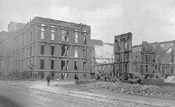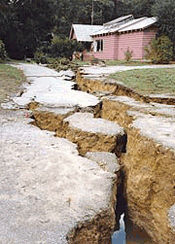|

A building in downtown San Francisco damaged in the
1906 quake.

This fissure was a result of the 1989 Loma Prieta
earthquake.

Damage on East Howard Street after the 1906
earthquake.
|
San
Jose
Introduction
Have you ever
considered how your city could withstand an
earthquake? This is a crucial question to think
about if you live in California because California
is considered "Earthquake Territory." In
particular, the San Francisco Bay Area is very
vulnerable to earthquakes. San Jose usually is not
the epicenter of earthquakes, but that does not
mean that the city does not get shaken! San Jose is
located southeast of San Francisco.
Nearby
Faults
|
Two
major fault systems are located near San
Jose. The San Andreas Fault system and the
Hayward Fault system. The San Andreas
Fault system is located to the west of San
Jose. The Hayward Fault system is located
to the east of San Jose. San Jose is
pretty much surrounded by the major fault
systems of Northern California.
|

|
The San Andreas Fault is very active. I'm
sure you remember one of the most memorable
earthquakes in Northern California, the 1906 San
Francisco earthquake. It was recorded that more
than 3,000 people died. 102 of the deaths occurred
in and near San Jose. Another well-known earthquake
was the 1989 Loma Prieta earthquake. According to
the 1990 studies by the United States Geological
Survey (USGS), there is a good chance that the next
big earthquake on the San Andreas Fault system
could occur near San Jose. It is said that the
earthquake will cause greater damage compared to
the 1989 Loma Prieta earthquake, because of the
increase of population.
�
The 1868
Hayward earthquake extended from San Jose to San
Pablo Bay, 74 miles northward. The 1868 earthquake
had a magnitude of an M7.0. More than 60 people
died, plus, there were over 3,000 injuries.
Damage
Towards Buildings
Most modern
buildings are safe during an earthquake (most
modern buildings are built to seismic standards).
Damage during an earthquake can result from the
strength of the shaking, the length of the shaking,
the type of soil that the buildings are founded on,
and the type of buildings that were built. The
strength of the shaking increases as the distance
of the earthquake decreases. Depending on how the
fault breaks during an earthquake factors how long
the earthquake will last. Greater damage occurs to
the buildings that shake the longest. Bayfill mud
is a type of substrate that causes a lot of shaking
because the soil is soft, thick, and wet,
therefore, making the ground unstable during an
earthquake (the shaking is increased). A big
problem for San Jose and San Francisco areas is
liquefaction. Because San Jose is located on
bayfill, the San Jose State Marine Station,
(located in Moss Landing) was damaged by
liquefaction. For residential structures,
structures of wooden-frame construction have
performed well in past earthquakes because they
tend to be light. Some major exceptions are older
structures (pre-1940s), irregular shaped newer
homes, and multi-story apartment buildings (or
houses).
Other
Information
|

|
There
have been at least four earthquakes in San
Jose (meaning that the epicenter was
located in San Jose). All of them had
magnitudes between M5.5-M6.5.
|
--by Margot Mansfield
�
�
�
�
|
�
|